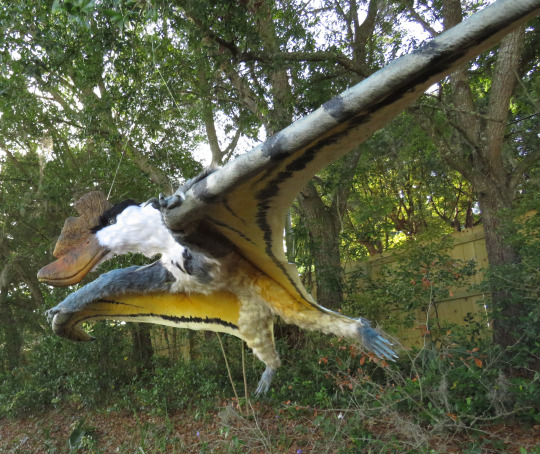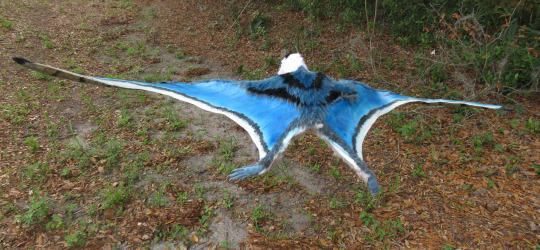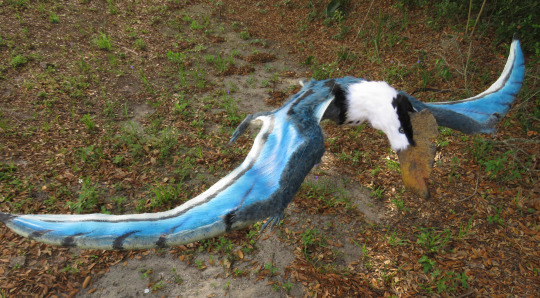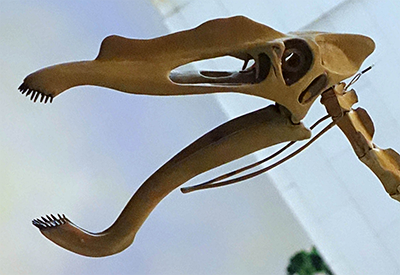#Cycnorhamphus
Explore tagged Tumblr posts
Text

Hello, Tumblr denizens! I am shackled to the whim of Instagram no longer. I am free to spread my queer agenda HERE, too.
I thought I’d start with one of my favorite little paleoarts I’ve done, this Cycnorhamphus suevicus: a pterosaur of peculiar rostrum and dubious diet. It had an almost rodent-like space between the tip and middle of its jaws, held by an odd soft tissue flange. Pink eared ducks have a similar Thing going on, and it might not be circumstantial.
I have fallen out of love with typical paleoart like this, but dinosaurs and legally similar animals will always have a special place in my heart.
#paleoart#paleontology#paleomedia#paleoillustration#paleoartist#digital art#digital illustration#pterosaur#Cycnorhamphus#Cycnorhamphus suevicus#art#artists on tumblr
40 notes
·
View notes
Text






Ancient paleojunk I did when I was 13 in early 2016. Obvious Cicchetti, Smaniotto and Martyniuk inspiration here. I'm glad to see my love of raptorial avisaurs ended up being vindicated. Someday everyone else will love opposite-birds just as much as I do.
The last one has a fun(?) story, I had a biology project, which I chose to due on Confuciusornis, obviously, and it was an infographic set on a big cardboard sign where numerous people would walk by and look. I remember seeing people get upset and turn away from my perfectly fine bird mauling illustration. SAD!
#eart from the heart#auld#watermarks are hardly necessary because of how bad these are but whateverrrrrrrrrrrrrrrrrrrrrrrrrrruh#anzu#ctenochasma#pterodactylus#germanodactylus#ardeadactylus#archaeopteryx#cycnorhamphus#soroavisaurus#yungavolucris#fukuivenator#confuciusornis#sinocalliopteryx
7 notes
·
View notes
Text
Recolors of Dimorphodon macronyx and Cycnorhamphus suevicus. I was gonna recolor Hatzegopteryx too but I decided against it.


With Hatsune Miku for scale:


#dimorphodon#cycnorhamphus#pterosaur#pterosauria#flying reptile#paleoart#digital doodle#digital doodles
10 notes
·
View notes
Text




Cycnorhamphus
#I give up this is the best I can photograph it#sculpture#pterosaur#nearly 8 foot wingspan makes it such a pain to drag around and heavy enough that it needs a kinda sturdy branch to hang from#and I'm not taking it AND a ladder into the park so
198 notes
·
View notes
Text
Some were scavengers.

(Art of Istiodactylus latidens by Gabriel Ugueto)
Some had unbelievable ornamentation.

(Art of Thalassodromeus sethi by Rudolf Hima)

(Art of Nyctosaurus gracilis by Julio Lacerda)

(Art of Cycnorhamphus suevicus by Chris Masnaghetti)
All of them were fuzzy.

Yet the media depiction of a “pterodactyl” tends to to be a shaved, toothed Pteranodon with the long tail of a Rhamphorhynchus.

Which is incredibly unfair to such a diverse, widespread clade. It’s like representing all mammals as some sort of hairless lion with a platypus beak and rat tail. And saying “This is my favorite reptile: the Mammali.”
(Pretend I felt like drawing the above hypothetical creature and put it here.)
Anyway, this is certainly not to mock people who say “Pterodactyl is my favorite dinosaur”, I just want to educate. Because it’s so unfair that this information is not more readily known cause pterosaurs are so cool! More people deserve to know Cool Things!
So yeah, what’s your favorite pterosaur? Mine’s probably Kunpengopterus but the azhdarchids are growing on me.
#it is time once again for me to suddenly hyperfixate on derailing someone’s post and battle Tumblr mobile for hours#pterosaurs#art#not mine#long post
687 notes
·
View notes
Photo

So it seems that I do really love drawing pterosaurs. It’s so much fun. Names of them: Harpactognathus - Cycnorhamphus - Caviramus Hamipterus - Zhenyuanopterus
#art#my art#paleoart#pterosaur#Harpactognathus#Cycnorhamphus#Caviramus#Hamipterus#Zhenyuanopterus#god i love these funky bitches
117 notes
·
View notes
Text

#Archovember Day 20 - Cycnorhamphus suevicus
Cycnorhamphus was a seagull-sized pterosaur with... a lot going on in the face area. It had peg-like teeth at the very tips of its jaws, a downward arc on its bottom jaw, and two soft-tissue structures on either side of its top jaw that fit into the bottom notch. It’s unknown what these adaptations were for, but it’s suggested that they may have worked as a sort of nutcracker for crushing mollusks.
However, some believe that the larger Cycnorhamphus specimen known as the “Painten Pelican” was a deformed individual, and these animals would otherwise have standard pterosaur jaws. This is countered with the argument that smaller, straighter-jawed specimens may be juveniles, and Cycnorhamphus would develop its weird bumps and curves as it matured.
#my art#Cycnorhamphus#Cycnorhamphus suevicus#pterosaurs#archosaurs#archosauromorphs#Archovember#Archovember2020#Dinovember#Dinovember2020#DrawDinovember#DrawDinovember2020#SaritaDrawsPalaeo
4 notes
·
View notes
Photo

Cycnorhamphus suevicus, a pterosaur from the Late Jurassic of Germany and France (~150-145 mya).
It had a wingspan of about 1.3m (4′3″), and was originally thought to look similar to Pterodactylus with long straight jaws -- but a well-preserved fossil nicknamed “the Painten Pelican” revealed its snout was actually much more oddly-shaped.

"Painten Pelican mount" by Mike Steele | CC BY 2.0 | cropped from original
It turns out Cycnorhamphus’s jaws arced outwards, creating an opening that seems to have become more pronounced as individuals reached adulthood. Soft-tissue impressions in the fossil also show some sort of stiff “flanges” on each side of the upper jaws, covering the gap and giving it a sort of bulldog-like appearance.
The function of this jaw structure is unknown for certain, but it’s been speculated to be a specialization for cracking open hard-shelled prey like molluscs.
#science illustration#paleontology#paleoart#palaeoblr#cycnorhamphus#pterosaur#gallodactylidae#ctenochasmatoidea#pterodactyloidea#stem-bird#lov the cronch#maybe#art#floof floof floof floof floof
639 notes
·
View notes
Text
Cycnorhamphus suevicus

By Chris Masnaghetti, retrieved from http://www.pteros.com/, a website dedicated to education about Pterosaurs.
A reminder that we will not be able to do every pterosaur until we reach $240 in donations on our patreon, so please donate even a dollar if you can.
Name: Cycnorhamphus suevicus
Name Meaning: Swan Beak
First Described: 1870
Described By: Seeley
Classification: Avemetatarsalia, Ornithodira, Pterosauromorpha, Pterosauria, Macronychoptera, Novialoidea, Breviquartossa, Pterodactylomorpha, Monofenestrata, Pterodactyliformes, Caelidracones, Pterodactyloidea, Archaeopterodactyloidea, Euctenochasmatia, Ctenochasmatoidea, Gallodactylidae
Cycnorhamphus is a Gallodactylid, a group of well-derived Archaeopterodactyloids with fewer than 50 teeth in the tip of the jaws, and rounded crests on the rear part of the skull. Cycnorhamphus was found in the Solnhofen Limestone of Germany, like so many other pterosaurs, and lived in the Tithonian age of the Late Jurassic, about 152 million years ago. It had peg like teeth at the jaw tip which were blunt and stout in older individuals and soft tissue structures at the jaw opening that are poorly understood. It had a lot of wear in its teeth which indicates it may have been eating tougher, grittier food, perhaps shellfish. It had highly twisted and curved jaws, though that could be due to deformation of the specimen. It also had a wingspan of about 1.35 meters, and was probably very specialized in order to compete with other pterosaurs in its ecosystem. It is probably synonymous with Gallodactylus.
Sources:
https://en.wikipedia.org/wiki/Cycnorhamphus
http://www.pteros.com/pterosaurs/cycnorhamphus.html
Shout out goes to @marty1489!
#cycnorhamphus#cycnorhamphus suevicus#pterosaur#gallodactylid#pterosaur ptuesday#marty1489#palaeoblr#paleontology#prehistory#prehistoric life#biology#science#nature#factfile
73 notes
·
View notes
Text
Django the Cycnorhamphus

Name: Django
Species: Cycnorhamphus suevicus*
Description: Cycnorhamphus, even by pterosaur standards, is weird. Originally thought to have a long straight beak (going off juvenile fossils), a new fossil shows its skull was much stranger. Not only did it have a large crest on the top of the head, two soft-tissue projections jut out of the upper jaw, and the lower jaw in turn curves. The teeth are peglike and restricted to the very, very front of the beak. Being one of many pterosaurs from late Jurassic Germany, this probably implies a specialized diet compared to other pterosaurs - perhaps hard-shelled food.
Location: Django is one of the many shore pterosaurs that lives in the Solnhofen Aviary, part of the Jurassic section of the Aquarium.
Fun Fact: The D is silent.
Personality & History: Django is, so far, our only Cycnorhamphus. The first Cycnorhamphus genome was pretty buggy, and as a result, only the wing finger properly developed on his left hand. He seems to get around fine with it. Django tends to isolate himself from the other pterosaurs, particularly the other Ctenochasmatoids. This doesn’t apply to the Rhamphorhynchus sisters, though. He often spends time near them, and in turn, Django is the only other pterosaur the Rhamphorhynchus won’t try to chase away.
Django likes altitude. We’ve observed him trying to climb on the ledges of the aviary’s framework, with mixed results. Even with one hand incompletely developed, he’s got a pretty good grip. He often tries standing on keepers’ heads when they enter the aviary. In response, we built him a special roosting platform near the top of the aviary, and he spends much of his time there, judging the other pterosaurs.
As with all the other pterosaurs in the aviary, Django has a special diet. This includes hard-shelled organisms, including mussels and snails, but also softer foods like worms, fish, and even the occasional jellyfish! For hard-shelled food, he holds the shell on his lower jaw, using his right hand to position it, and uses the upper jaw projections to cleave it open.
#thhpg#aotw#django#Cycnorhamphus#Cycnorhamphus suevicus#Solnhofen Aviary#Aquarium - Jurassic Section#pterosaur#palaeoblr#huxley paleozoo
37 notes
·
View notes
Text

The Ubiquity of the Starbucks (self-portrait with streetscape in a museum window) R. Jake Wood, 2021.
Yep, there’s a Starbucks in that scene -- in the white building center back.
The Carnegie Museum of Art: Pieces and Other Things
Besides just re-visiting the Grand Staircase and The Crowning of Labor at the Carnegie Museums, I also spent some time wandering through the art museum, ‘cause why not? There’s either works I haven’t seen, or works to see again – either way, time’s usually well spent in a museum. I hadn’t figured on taking any photos while wandering, but that was a silly thought; there’s almost always something that will prompt me to lift the camera and snap off a shot or three.

When the architects were planning the museum’s staircase and sculpture courtyard -- with trees -- did they imagine the intersecting and convergent lines that would result when one viewed it all “just so?” Maybe, maybe not, but it worked for me so I took some photos.

I was also caught by the juxtaposition of this bronze, Night by Aristide Maillol (1939), a curvy figure set in a world of straight lines. Yep, I get artsy, too, sometimes.
I like the “ah I see what you did there” moments that curators will set-up, ostensibly for educational purposes, I’m sure -- but I like to imagine them thinking “Let’s just see who actually notices this.” Here:

Mrs. Trevor by George Romney, 1779-80
and:

Terpsichore, Muse of Lyric Poetry by Antonio Canova, 1812 (plaster model).
I mean, it’s obvious, right?

Canova’s Terpsichore is, according to the accompanying placard, exemplar of the Neoclassical style -- as is the portrait of Mrs. Trevor. They were positioned intentionally, but I wonder just who actually catches on.
Besides taking photos of the art, I also returned to doing something I haven’t done for some time (because covid): taking photos of people looking at art, or taking photos of art.



Visitors with van Gogh’s Wheat Fields After the Rain (The Plain of Auvers).

And from my visit to the Natural History Museum in July: a visitor with the Pterosaur (Cycnorhamphus) Flock.
Photos: R. Jake Wood, 2021.
Carnegie Museum of Art website
0 notes
Video
youtube
Prehistoric Information- Cycnorhamphus
0 notes
Text
Cycnorhamphus suevicus. Sorry this one isn’t that good, I was very tired when I made it.

With Hatsune Miku for scale:

6 notes
·
View notes
Text
Rhamphorhynchus longicaudus, R. muensteri, R. etchesi

By Chris Masnaghetti, retrieved from http://www.pteros.com/, a website dedicated to education about Pterosaurs.
A reminder that we will not be able to do every pterosaur until we reach $240 in donations on our patreon, so please donate even a dollar if you can.
Name: Rhamphorhynchus longicaudus, L. muensteri, R. etchesi
Name Meaning: Beak Snout
First Described: 1846
Described By: Meyer
Classification: Classification: Avemetatarsalia, Ornithodira, Pterosauromorpha, Pterosauria, Macronychoptera, Novialoidea, Breviquartossa, Rhamphorhynchidae, Rhamphorhynchinae
Have you ever wondered, hmm, I wonder what the best known pterosaur is, then you’ve come to the right place. Say hello to Rhamphorhnychus, a genus known from a truly astonishing number of specimens, that has allowed us to piece together much of its life history and ecology. It lived in the Late Jurassic of Europe, about 150.8 to 148.5 million years ago in the Tithonian age, and while fragmentary skeletons are found in various places throughout Europe, it’s most famous home is the Solnhofen Limestone of Germany. Many of its remains are complete and articulated, with some that are soft tissue, others three dimensional, and we have a complete ontogenetic sequence. There’s even coprolites known! It had a wingspan of about 1.5 to 1.8 meters long as an adult, and it had fairly narrow wings as well.

By Henry Thomas on @raptorcivilization
Rhamphorhynchus also had conical teeth that were fairly large and sticking out of its mouth, upturned jaw tips, and a long tail with a vane at the end that is at least confirmed - other pterosaurs are restored with this vane, but it’s uncertain if they really had them. Rhamphorhynchus thus used its large teeth to catch fish - it was decidedly a piscivore, with remains known from the guts from multiple specimens. One Rhamphorhynchus even swallowed a fish nearly as long as its own body, which would have lead to the pterosaur extending its throat just to get the slimy thing down (like modern crocodilians and birds can do). Small fish are also known to have been consumed by Rhamphorhynchus. As for the coprolites? They might indicate that Rhamphorhynchus also ate cephalopods, but this is fairly speculative at this time.

By John Conway, CC BY-SA 3.0
Despite being frequently shown doing so, Rhamphorhynchus was not a skim feeder - doing so would have ripped its jaw from its body. It also held its head parallel to the ground, allowing it balance itself as it flew. However it probably did most of its foraging while swimming, using its broad and large feet to propel itself through the water - and it being able to swim would have lead to it being preserved a fairly frequent number of times. It also was food for other things, of course - crocodylomorphs perhaps, but also possibly the predatory fish Aspidorhynchus acutirostris, which is much larger than Rhamphorhynchus and has been found associated with it in multiple specimens, including one that preserves the wing membranes of the pterosaur. The number of specimens with these two associated together indicates that Aspidorhynchus was routinely feeding on Rhamphorhynchus, and that oftentimes this predatory behavior would lead to their dying together in anoxic and other inhospitable regions of the lagoons, thus leading to excellent preservationg.

Infant by Henry Thomas on @raptorcivilization
It’s growth sequence is well known as well, and quite interesting: though there is no evidence that Rhamphorhynchus cared for its young, and the smallest individuals at 290 mm long were probably able to fly - though not like the adults, leading to questions as to their ecological role. It is possible that juveniles would have climbed trees and branches like hoatzin chicks, eating small arthropods. The juveniles had shorter skulls and larger eyes, and blunter aws, with shallower vanes on the tail - the vane would become diamond shaped as they grew and then triangular in the oldest adults. The number of teeth would not change as they grew, though the shape of the jaws would. They grew fast in the first few years of life and then growth would slow down after reaching sexual maturity, and though they grew faster than alligators, they still showed different growth patterns than more derived pterosaurs such as Pteranodon. They don’t reach a determined size, like endothermic animals, but whether or not they were ectothermic is uncertain.

By ДиБгд, in the Public Domain
Rhamphorhynchus lived in an environment with many lagoons and marine ecosystems, feeding on ocean going fish and being fed on by fish itself - it was, essentially, a Mesozoic Gull. It may have been more aquatic than any other pterosaurs, leading to its decent preservation, but was definitely a common sight in Late Jurassic Germany. As for animals it lived alongside, these included many invertebrates and fish, but also many types of lizards, tuatara-relatives, and turtles, as well as the Crocodylomorphs Alligatorellus, Cricosaurus, Dakosaurus, Geosaurus, and Rhacheosaurus, Ichthyosaurs such as Aegirosaurus, other pterosaurs like Scaphognathus, Pterodactylus, Germanodactylus, Ctenochasma, Cycnorhamphus, Gnathosaurus, Anurognathus, Ardeadactylus, Aurorazhdarcho, and Aerodactylus, and even some dinosaurs - specifically, Compsognathus and Archaeopteryx.
Sources:
https://en.wikipedia.org/wiki/Rhamphorhynchus
https://en.wikipedia.org/wiki/Paleobiota_of_the_Solnhofen_Formation
http://markwitton-com.blogspot.com/2016/04/the-lives-and-times-of-flying-reptiles.html
http://www.pteros.com/pterosaurs/rhamphorhynchus.html
Shout out goes to @plasterxxx!
#rhamphorhynchus#pterosaur ptuesday#pterosaur#rhamphorhynchid#palaeoblr#Rhamphorhynchus longicaudus#rhamphorhynchus muensteri#rhamphorhynchus etchesi#paleontology#prehistory#prehistoric life#biology#science#nature#factfile
112 notes
·
View notes